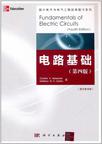电路基础
2011-8
科学出版社
(美)亚历山大 著
924
《电路基础(第四版)(英文影印版)》
讲述了电路课程的基础知识,分为三个部分:第一部分是直流电路,包括基本定律和定理、无源元件及有源元件。第二部分是交流电路,包括相量、正弦稳态分析、功率、有效值、三相电路和频率响应。第三部分包括拉普拉斯变换、傅里叶级数、傅里叶变换和二端口网络分析。本书以电路的基础知识、分析方法为主体,并在此基础上适当地做了有创意的延伸与发展,加强了它与新技术的联系。
《电路基础(第四版)(英文影印版)》 可作为电类各专业课程的双语教材或参考书,也可供工程技术人员参考。
preface xi
acknowledgments xvi
guided tour xviii
a note to the student xxiii
about the authors xxv
part 1 dc circuits 2
chapter 1 basic concepts 3
1.1 introduction 4
1.2 systems of units 4
1.3 charge and current 6
1.4 voltage 9
1.5 powerand energy 10
1.6 circuit elements 15
1.7 *applications 17
1.8 *problem solving 20
1.9 summary 23
chapter 2 basic laws 29
2.1 introduction 30
2.2 ohm's law 30
.2.3 *nodes, branches, and
loops 35
2.4 kirchhoff's laws 37
2.5 series resistors and voltage division 43
2.6 parallel resistors and current division 45
2.7 *wye-detta transformations 52
2.8 *applications 58
2.9 summary 64
chapter 3 methods of analysis 81
3.1 introduction 82
3.2 nodal analysis 82
3.3 nodal analysis with voltage sources 88
3.4 mesh analysis 93
3.5 mesh analysis with current sources 98
3.6 *nodal and mesh analyses by inspection 100
3.7 nodal versus mesh analysis 104
3.8 circuit analysis with pspice 105
3.9 *applications: dc transistor circuits 107
3.10 summary 112
chapter 4 circuit theorems 127
4.1 introduction 128
4.2 linearity property 128
4.3 superposition 130
4.4 source transformation 135
4.5 thevenin's theorem 139
4.6 norton's theorem 145
4.7 *derivations of thevenin's and norton's theorems 149
4.8 maximum power transfer 150
4.9 verifying circuit theorems with pspice 152
4.10 *applications 155
4.11 summary 160
chapter 5 operational amplifiers 175
5.1 introduction 176
5.2 operational amplifiers 176
5.3 ideal op amp 179
5.4 inverting amplifier 181
5,5 noninvertingamplifier 183
5.6 summing amplifier 185
5.7 difference amplifier 187
5.8 cascaded qpamp circuits 191
5.9 op amp circuit analysis with pspice 194
5.10 tapplications 196
5.11 summary 199
chapter 6 capacitors and inductors 215
6.1 introduction 216
6.2 capacitors 216
6.3 series and parallel capacitors 222
6.4 inductors 226
6,5 series and parallel inductors 230
6,6 applications 233
6.7 summary 240
chapter 7 first-order circuits 253
7.1 introduction 254
7.2 thesource-free rccircuit 254
7.3 the source-free rt circuit 259
7.4 singularity functions 265
7.5 step response of an rccircuit 273
7.6 step response of an rt circuit 280
7.7 tfirst-qrder op amp circuits 284
7.8 transient analysis with pspice 289
7.9 applications 293
7.10 summary 299
chapter 8 second-order circuits 313
8.1 introduction 314
8.2 finding initial and final values 314
8.3 the source-free series rtc circuit 319
8.4 the source-free parallel rtc circuit 326
8.5 step response of a series rlc circuit 331
8.6 step response of a parallel rlc circuit 336
8.7 general second-order circuits 339
8.8 second-order op amp circuits 344
8.9 pspice analysis of rtccircuits 346
8.10 *duality 350
8.11 tapplications 353
8.12 summary 356
part 2 ac circuits 368
chapter 11 sinusoids and phasors 369
9.1 introduction 370
9.2 sinusoids 371
9.3 phasors 376
9.4 phasor relationships for circuit elements 385
9.5 impedance and admittance 387
9.6 *kirchhoff's laws in the frequency domain 389
9.7 impedance combinations 390
9.8 tapptications 396
9.9 summary 402
chapter 10 sinusoidal steady-state analysis 413
10.1 introduction 414
10.2 nodal analysis 414
10.3 mesh analysis 417
10.4 superposition theorem 421
10.5 source transformation 424
10.6 thevenin and norton equivalent circuits 426
10.7 qp amp ac circuits 431
10.8 ac analysis using pspice 433
10.9 tapptications 437
10.10 summary 441
chapter 11 ac power analysis 457
11.1 introduction 458
11.2 instantaneous and average power 458
11.3 maximum average power transfer 464
11.4 effective or rms value 467
11.5 apparent power and power factor 470
11.6 complex power 473
11.7 tconservation of ac power 477
11.8 power factor correction 481
11.9 tapplications 483
11.10 summary 488
chapter 12 three-phase circuits 503
12.1 introduction 504
12.2 balanced three-phase voltages 505
12.3 balanced wye-wye connection 509
12.4 balanced wye-delta connection 512
12.5 balanced delta-delta connection 514
12.6 balanced delta-wye connection 516
12.7 power in a balanced system 519
12.8 tunbalanced three-phase systems 525
12.9 pspice for three-phase circuits 529
12.10 tapptications 534
12.11 summary 543
chapter 13 magnetically coupled circuits 555
13.1 introduction 556
13.2 mutual inductance 557
13.3 energy in a coupled circuit 564
13.4 linear transformers 567
133 ideal transformers 573
13.6 idealautotransformers 581
13.7 tthree-phase transformers 584
13.8 pspiceanatysis of magnetically coupled circuits 586
13.9 applications 591
13.10 summary 597
chapter 14 frequency response 613
14.1 introduction 614
14.2 transfer function 614
14.3 tthe decibel scale 617
14.4 bode plots 619
14.5 series resonance 629
14.6 parallel resonance 634
14.7 passive filters 637
14.8 active filters 642
14.9 scaling 648
14.10 frequencyresponse using pspice 652
14.11 computation using matlab 655
14.12 applications 657
14.13 summary 663
part 3 advanced circuit analysis 674
此处删去原书第15.16章。
chapter 17 the fourier series 755
17.1 introduction 756
17.2 trigonometric fourier series 756
17.3 symmetry considerations 764
17.4 circuit applications 774
17.5 average power and rms values 778
17.6 exponential fourier series 781
17.7 fourier analysis with pspice 787
17.8 tapplications 793
17.9 summary 796
此处删去原书第18章。
chapter 19 two-port networks 849
19.1 introduction 850
19.2 impedance parameters 850
19.3 admittance parameters 855
19.4 hybrid parameters 858
19.5 transmission parameters 863
19.6 trelationships between
19.7 interconnection of networks 871
19.8 computing two-port parameters using pspice 877
19.9 tapplications 880
19.10 summary 889
appendix a simultaneous equations and matrix inversion a
appendix b complex numbers a-9
appendix c mathematical formulas a-16
appendix d pspice for windows a-91
appendix e matlab a-46
appendix f kcide for circuits a-65
appendix g answers to odd-numbered problems a-75
bibliography b-1

适合英语能力强的学,基础全面
原著经典,但对影印版非常愤怒!既然有删节为什么不说清楚??科学出版社的编辑既然引进了,干嘛要删掉15、16、18三章?????傅里叶变换和拉斯变换难道能砍掉吗?这就是你们引进图书的态度?建议大家以后不要买科学出版社的影印版!!!!